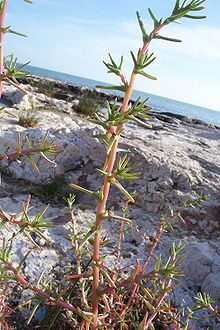Salsola soda
| Salsola soda | |
|---|---|
 |
|
| Scientific classification | |
| Kingdom: | Plantae |
| (unranked): | Angiosperms |
| (unranked): | Eudicots |
| (unranked): | Core eudicots |
| Order: | Caryophyllales |
| Family: | Amaranthaceae |
| Subfamily: | Salsoloideae |
| Genus: | Salsola |
| Species: | S. soda |
| Binomial name | |
|
Salsola soda L. |
|
Salsola soda, more commonly known in English as opposite-leaved saltwort, oppositeleaf Russian thistle, or barilla plant, is a small (to 0.7 m tall), annual, succulent shrub that is native to the Mediterranean Basin. It is a halophyte (a salt-tolerant plant) that typically grows in coastal regions and can be irrigated with salt water.
The plant has great historical importance as a source of soda ash, which was extracted from the ashes of Salsola soda and other saltwort plants. Soda ash is one of the alkali substances that are crucial in glassmaking and soapmaking. The famed clarity of 16th century cristallo glass from Murano and Venice depended upon the purity of "Levantine soda ash," and the nature of this ingredient was kept secret. Spain had an enormous 18th century industry that produced soda ash from the saltworts ( in Spanish). Soda ash is now known to be predominantly sodium carbonate. In 1807, Sir Humphry Davy isolated a metallic element from caustic soda; he named the new element "sodium" to indicate its relationship to "soda." Before soda was synonymous (in U.S. English) with soft drinks, the word referred to Salsola soda and other saltwort plants, and to "sodas" derived from soda ash.
While the era of farming for soda ash is long past, Salsola soda is still cultivated as a vegetable that enjoys considerable popularity in Italy and with gourmets around the world. Its common names in Italian include barba di frate, agretti, and liscari sativa (short: lischi or lischeri). Of its culinary value, Frances Mayes has written that "Spinach is the closest taste, but while agretti has the mineral sharpness of spinach, it tastes livelier, full of the energy of spring."
This annual, succulent plant can grow into small shrubs up to 0.7 meters tall (sometimes called sub-shrubs). It has fleshy green leaves with either green or red stems. The tiny flowers develop from inflorescences that grow out of the base of the leaves near the stem.
...
Wikipedia
